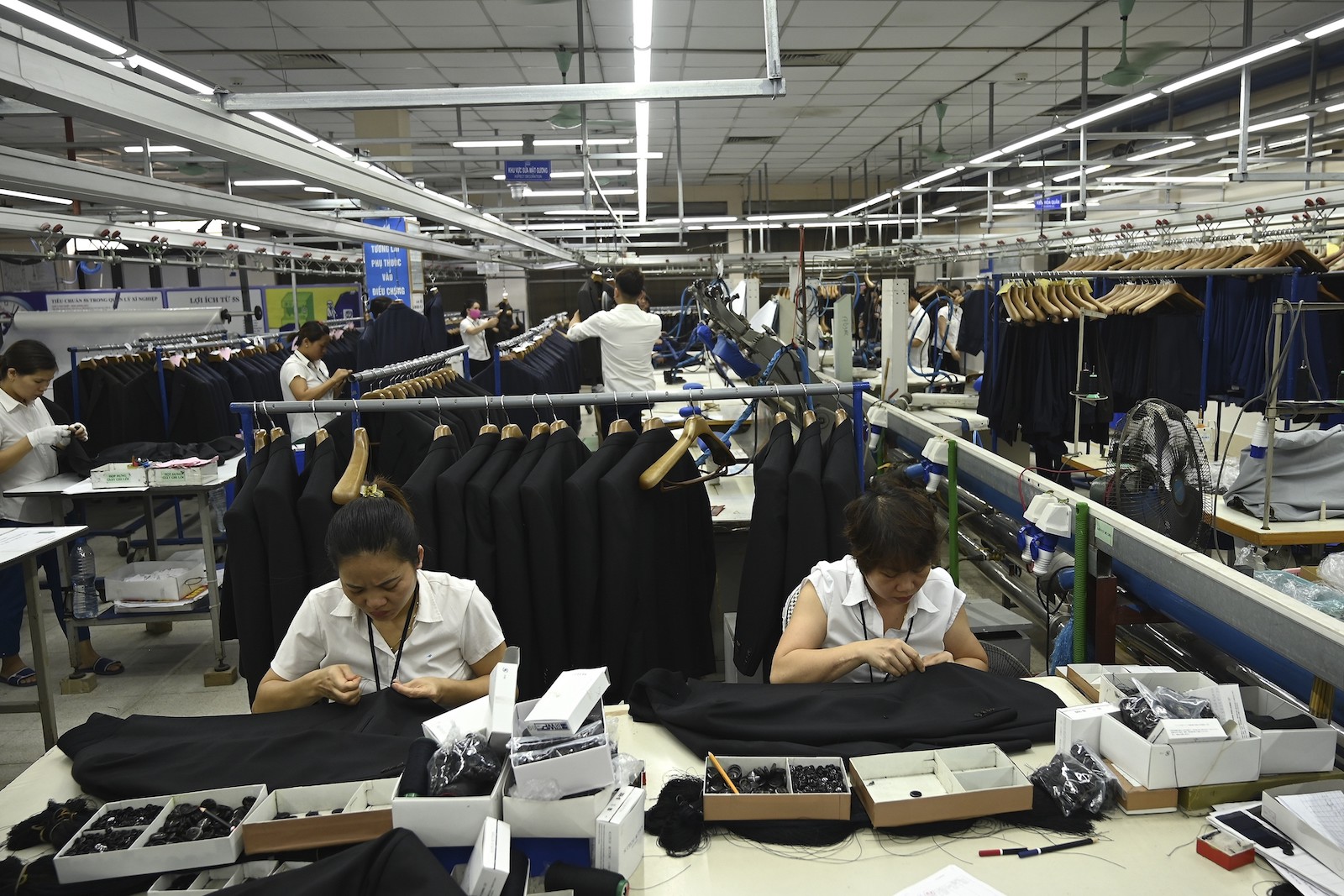Coronavirus Exposes Dependency of Southeast Asia’s Manufacturers on China

Garment factory workers making suits in Hanoi, Vietnam. The trade war represented an opportunity for the country to double down on its high-end manufacturing credentials.
Photo: Manan Vatsyayana, AFP via Getty Images
Southeast Asian manufacturers hoped the U.S.-China trade war would elevate their position as a global production hub, at the expense of their giant neighbor to the north. But the spread of the coronavirus has brought home the extent to which their fortunes are tightly intertwined with those of China.
The United States and China called a truce with a “Phase 1” deal in early 2020, but the trade war persists as many tariffs have remained in place. On the face of it, Southeast Asian countries are the clear winners of the protracted conflict between the world’s two largest economies. In 2019, U.S. imports from China dropped by 16% ($87 billion) in response to a raft of tariffs imposed on Chinese goods. Yet overall, imports only dropped by 1.7%, meaning that U.S. business lost by China was being picked up elsewhere.
The biggest gainers? Cambodia and Vietnam, from where U.S. imports grew on an annual basis by 38% ($5.9 billion) and 36% ($17.5 billion), respectively. Southeast Asian countries have long been an extension of a “China, Plus One” strategy where manufacturers diversified the risks of establishing core production in China by maintaining a base in at least one other country. As the trade war ratcheted up, many companies leaned into the “Plus One” aspect of their operations or began the process of reconfiguring supply chains to reduce the pain of exporting from China.
Vietnam is a case in point. As a major production base for garment and other lower-end manufacturing companies, the trade war represented an opportunity for the country to double down on its high-end manufacturing credentials. Vietnam is already a vital manufacturing hub for the likes of Intel, LG and Samsung Electronics, which employs more than 100,000 people in the country. Vietnam is rising in prominence as a global technology manufacturer, especially as the trade war has brought to life the risks of overdependence on Chinese production.
U.S. tariffs helped to bolster Vietnam’s position — Chinese data indicates that exports from China to Vietnam grew by 14% between 2018-19 as more businesses shifted production capacity to circumvent tariffs on “Made in China” goods. This has sometimes happened in nefarious ways: Materials and goods flowing to Vietnam have been labelled “Made in Vietnam” in an attempt to avoid tariffs.
The Cambodian government has announced that 110,000 workers across 200 factories will likely be suspended in March.
Southeast Asia’s apparent gains from the trade war detract from how tightly the manufacturing sectors of these countries are linked to Chinese supply chains. They are the beneficiaries of China’s push to move higher up on the manufacturing value chain. Even though Southeast Asia is emerging as a viable alternative for lower-end production, it remains highly dependent on China for equipment and raw materials to power its manufacturing sectors. For example, Cambodia’s garment factories are almost wholly dependent on China for textiles, while Vietnamese electronics manufacturers are hungry for plastics, metals and other components. So much that Vietnamese government data showed a trade deficit with China of $34 billion in 2019, up 40% from $24 billion in 2018. Without inputs from China, and with no contingency factored into their supply chains, the factories of Southeast Asia have little chance of meeting this surge in demand from the United States. Regional relationships, already strained by Chinese territorial ambitions in the South China Sea, are shaped by the fact that no Southeast Asian manufacturing hub can afford to be cut off from inputs from China.
In the short-term, at least, the coronavirus outbreak has turned this threat into a reality. Quarantine measures have kept factory workers at home across China, while restrictions in movement of people and goods have led to the slowing or halting in production of the materials and equipment so badly needed in Southeast Asia.
The effects of this are reverberating through the region’s supply chains. Some factories in Vietnam and Cambodia have been forced to shut down, with disruption to supplies from China impacting their ability to meet orders. Delays from Vietnamese garment manufacturers, reliant on Chinese textile inputs, have reportedly led to a two-week lag in shipments for Japanese fashion giant Uniqlo, while the Cambodian garment industry has also been hit hard by supply issues. The Cambodian government has announced that 110,000 workers across 200 factories will likely be suspended in March as a result.
With no concrete end to the trade war in sight, Southeast Asia must strike a fine balance between the lure of U.S. markets and the need to maintain good relations with its primary supplier. The coronavirus outbreak is testing a scenario in which China turns off the tap of raw materials to Southeast Asian countries — and it does not bode well for their manufacturing prospects. For multinationals re-examining their supply chains in response to COVID-19, a “China, Plus Two” strategy may be worth considering, with an alternative to China and Southeast Asia in the mix.








